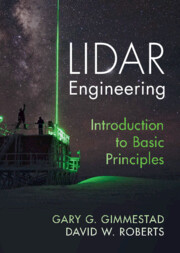Book contents
- Lidar Engineering
- Lidar Engineering
- Copyright page
- Dedication
- Contents
- Preface
- Glossary
- List of Abbreviations
- 1 Introduction
- 2 The Basic Lidar Models
- 3 The Molecular Atmosphere
- 4 Particles in the Atmosphere
- 5 Lidar Transmitters
- 6 Lidar Receivers and the Geometrical Function
- 7 Optomechanics
- 8 Optical Detection
- 9 Data Systems
- 10 Lidar Data Analysis
- 11 Applications
- Appendix A The Klett Retrieval
- Index
- References
6 - Lidar Receivers and the Geometrical Function
Published online by Cambridge University Press: 16 February 2023
- Lidar Engineering
- Lidar Engineering
- Copyright page
- Dedication
- Contents
- Preface
- Glossary
- List of Abbreviations
- 1 Introduction
- 2 The Basic Lidar Models
- 3 The Molecular Atmosphere
- 4 Particles in the Atmosphere
- 5 Lidar Transmitters
- 6 Lidar Receivers and the Geometrical Function
- 7 Optomechanics
- 8 Optical Detection
- 9 Data Systems
- 10 Lidar Data Analysis
- 11 Applications
- Appendix A The Klett Retrieval
- Index
- References
Summary
The main components of a lidar receiver include the telescope, a field stop, a collimating lens, an optical filter, a field lens, and a detector. These elements are discussed sequentially. Incidence angle and temperature effects on filter response are quantified, and techniques for filter tuning are described. Common spectral shapes of interference filters are given along with their equivalent rectangular widths. Filter aging effects are described, with examples. Polarization sensitivity in receivers is discussed, along with a review of common lidar polarization analyzers. An actual lidar receiver design is described as an example. The shape of the geometrical function (also called the crossover or overlap function) is shown, and a review of geometric optics is given. Engineering the geometrical function is then discussed at length, with many diagrams. Formulas for finding the start and end of crossover are derived, and a graphical technique is introduced for visualizing the results. A two-receiver method for monitoring much of the geometrical function is illustrated with an example. Finally, comments on methods for achieving lidar transmitter–receiver alignment are presented.
Keywords
Information
- Type
- Chapter
- Information
- Lidar EngineeringIntroduction to Basic Principles, pp. 143 - 183Publisher: Cambridge University PressPrint publication year: 2023
